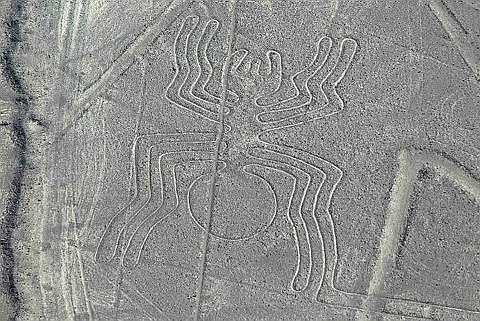Tomatoes, potatoes, corn(although none of these are mentioned in the report) and ending
Never finished always in need of repair.We'll never know the full story, but here is the "never finished, always in need of repair" work-in-progress Peru report:
Alpaca, vicuna, llama
Dear family and friends,
As many of you know, I have now been home for more than two weeks but I feel obliged to send one more letter to finish the chronicle of my South American trip and not leave you thinking I am still strapped in the seat of a Cesna 172 and flying around over the Nazca Lines.
 |
| image borrowed from http://www.cuscocity.com/store/products/NAZCA-LINES-WORLD-MISTERY.html |
After the stomach churning flight over those fascinating artifacts, our group visited the nearby Cemetery of Chauchilla. What the cemetery is, in fact, is an area with an estimated 900 tombs, shallow pits, in which the mummified remains of the deceased were interred. At the risk of being too grisly, the dead were eviscerated, had the tendons of their limbs severed, after which the remains were forced into the foetal position, then wrapped in cotton and alpaca wool fabrics and placed in the tombs for their journey to the beyond. Most of these tombs have been relentlessly plundered by ‘huaquero’, literally ‘robbers of huacas’, a huaca being a temple, shrine, or burial site. The dead, particularly the nobility and royalty, were regularly buried with displays of their wealth, precious gems, ceramics, gold, and silver. Since the Spanish conquest, huaqueros have ransacked these sites so thoroughly that an undisturbed site is rarely found. Today what one sees is a number of exposed pits with a few mummies, many bones and skulls, scraps of cloth and shards of ceramics.
From the Nazca area, an overnight bus took us away from the coastal lowlands to Arequipa, a city of some 700,000 at 2325m in the desert of the western Andes. Desert it may be, but Arequipa is a lovely city in a beautiful setting with welcoming green vegetation on the surrounding spectacular mountains. The most famous of the backdrop mountains is snow clad El Misti which towers above the others and which is clearly seen from most everywhere in the city. Many of the buildings date from the early colonial times and those around the central Plaza de Armas are particularly inviting with second story balconies, now almost entirely occupied by restaurants overlooking the square. Many of the buildings are constructed from a light-coloured stone. Reflecting sunlight, these dazzling buildings have earned Arequipa the nickname ‘the white city’.
Aside from architecture, the people are simply lovely. Hostesses stand outside the restaurants to lure you in. Very quickly, you have been formally welcomed to Arequipa, you will know their name, they will know yours, should you not go in on the spot, an invitation for a later time is offered. All this is done without them ever seeming aggressive or pushy and they are so gracious, it is easy to believe they are totally sincere. Should you chance to walk by later on you almost certainly will hear “Hello Merv, remember me, Maria (or Teresa, or Juanita), welcome, please come in.” I really liked Arequipa. It would be my number one city recommendation for anyone visiting Peru.
But tourists primarily come to Peru to visit the remains of the Inca civilization, one of the three exceptional pre-Columbian cultures of the Americas (the others were the Aztec of Mexico, and the Maya based in the Yucatan and Central America). A twenty minute flight, to avoid a ten hour bus ride, took us from Arequipa to Cuzco, the once powerful, thriving, historical center of the Inca Empire high in the Andes. The setting for Cuzco is as beautiful as one could imagine, surrounded by stunning Andean mountains, covered in tropical vegetation and capped with snow.
The period dominated by the Inca is, in fact, no longer referred to as the ‘Empire’, but rather it is now being referred to as the Inca Period, recognizing that the Incas were just one manifestation of the Quechua people who were predominate in the area then, and remain so today. It is notable that the Inca period of ascendancy, during which the extensive ‘Empire’ was carved out, lasted less than 150 years. At its peak, Cuzco was home to some 500,000 people. After the Spanish conquest Cuzco was subjected to the usual looting and destruction, then the Spanish, being a seafaring nation, established their new capital at Lima and Cuzco dwindled to a population of 15,000.
All that changed when, in 1911, an American historian, Hiram Bingham, stumbled on the ‘Lost City of the Incas’, the ruins of Machu Picchu. South America’s most spectacular archaeological site, Machu Picchu is said to be the best known and least known of the Inca ruins. Located some 100km from Cuzco, it seems clear that the Spanish never knew of its existence, it is not mentioned in any of their chronicles, but more compelling to me is that they certainly would have looted it had they known. The purpose of the site is also not known. Built at the very apex of a sheer faced mountain, it is thought to have had a religious, or educational, or astrological purpose, possible all three, but regardless, the exceptionally high quality of the stonework assures that it was of primary ceremonial significance
To be continued…
No comments:
Post a Comment